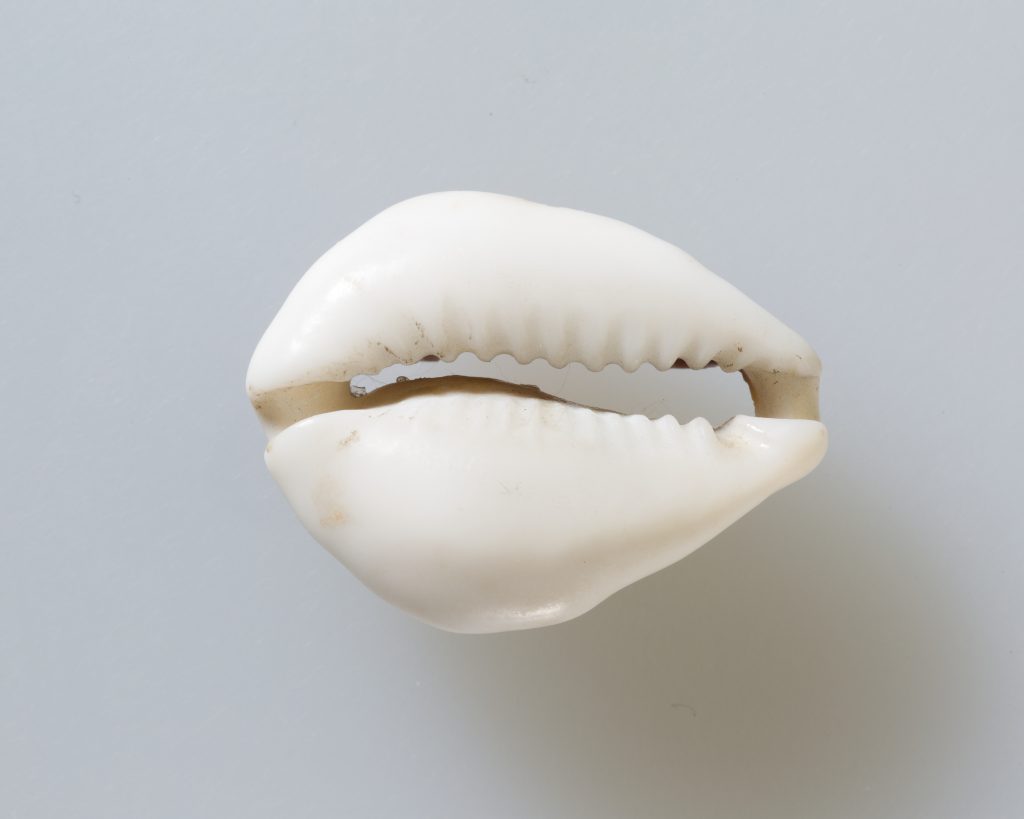Cowrie shells are the shells of small marine snails that are widely distributed in warm seas. Their texture is very smooth due to their glossy finish, and they come in various shapes, patterns, and colors. Although we simply use them for a collection, Cowrie shells had many uses and purpose in ancient times, particularly in ancient Egypt.
In ancient Egypt, women were highly valued for their ability to conceive children. In order to protect their fertility for the future, girls and young women wore Cowrie girdles. They would also be worn during pregnancy in order to protect their child from any harm or complications, and have a safe and successful delivery. It was also believed that women and children in ancient Egypt were often the targets of the so-called evil eye, an evil spirit that would haunt them and was the blame for miscarriages and deaths. The only way to stay protected from the malicious effects of the superstition was by wearing Cowrie shells every day for the rest of their lives. Even when Egyptian women died, they were often buried with a Cowrie shell necklace to protect their spirits in the after life. Cowrie girdles were often adorned by a small naked female that represented the goddess of fertility, and she protected pregnant women throughout their pregnancies. Even though pregnant women were often visited by female birth attendants to make sure that their pregnancy was going well, the Cowrie shells gave them an added sense of protection. After examining the remains of numerous mummies, Egyptian scholars have concluded that Egyptian females must have had fertility difficulties due to their lack of medicine and resources. Those scholars conclude that these women must have depended on their belief in the power of these Cowrie shells. The shape of the Cowrie shell was even thought to symbolize a woman’s pregnancy due to its round shape, seen as similar to a woman’s pregnant belly as the child grows. The vertical opening in the middle of the shell represents the female vulva, which is the main reproductive organ of the woman.1

Gold | Courtesy of the Metropolitan Museum of Art, New York
Cowrie shells in ancient Egypt were also known to be used for decoration purposes. In the tombs of small children, the Cowrie shells were placed around tombs for decoration purposes. There were two very different designs, one for the girls and one for the boys. They were thought to offer a connection between the living and the dead. Cowrie shells were also very valuable, and they were used as jewelry as well, and as home décor. The more Cowrie shells one had, the wealthier one was thought to be, and the more respect one was accorded by the people. Because of their high value, Cowrie shells were commonly used as currency; and they traded the shells for things like food, clothing, and other necessities. In the homes of the Egyptians, there were animal figures that were covered with Cowrie shells. The jewelers who created the decorations and the necklaces used metals to fill the Cowrie shells so that they would make sounds that would capture attention. The jewelers would add gold to the Cowrie shells that would make the shells even more valuable. Such shells were seen as a symbol of the flesh of the gods that were linked to the sun. Silver, another metal added to the shells, represented the bones of the gods and was associated with the moon. The animal that was most used by the ancient Egyptians was the cat. Like the women and children, the Cowrie shells were also used to protect the lives of the animals from evil spirits.2
In conclusion, the ancient Egyptians valued Cowrie shells, and they used for them for many purposes. One of the purposes was their belief that the shells gave some type of protection to women and children from evil spirits. They also protected the lives of the dead when they placed Cowrie shells over their tombs. They also made girdles for pregnant women, who would wear them on their hips in order to protect their wombs and have safe deliveries. When used as necklaces, the Cowrie shells were filled with metals like gold and silver, which gave them significance. We spot them today on the shores of our beaches and don’t realize the importance they have had in the past and the meanings they have carried for lives lived long ago.
- Bill Bynum and Helen Bynum, “Egyptian Cowrie Necklace,” The Lancet Vol. 386, No. 1003 (2016): 1525. ↵
- Amir Goalni, “Cowrie shells and their imitations as ornamental amulets in Egypt and the Near East,” Polish Archaeology in the Mediterranean, Special Studies: Beyond ornamentation 23/2, (2014): 71-94. ↵



53 comments
Samuel Ruiz
I have often seen the Cowrie shell around, but I never thought it was used symbolically before. While reading the article, I kept noticing a resemblance between the Cowrie shell and the dream catcher that is often used in Native American cultures. Although the dream catcher was not used for pregnancy, it was a symbolic piece of protection. It is also often used as a decorative piece today, like the Cowrie shell. Awesome article!
Destiny Flores
It is so fascinating to think that something so small, and natural, like the Cowrie Shells, could have such a huge impact on a culture. It’s seen in the economic aspect, the spirituality of the people from evil and good, and even dead or alive, the fertility of women, the gender stratification of the society, and even seen to have relations to the weather and moon cycles. So pretty much every aspect of these individuals lives, had a part of these shells.
Arianna Kennet
This article was fairly interesting and I honestly never knew the different purposes of the Cowrie Shell. What a surprise to know it was used as protection from the evil spirits for pregnant woman, who would’ve thought. Its interesting how they use it when they are pregnant and they are buried with a cowrie shell necklace too, showing that it is present during both life and death.
Johnanthony Hernandez
I’ve found it interesting since I was a child how something as simple as a shell such as Cowrie shells could have multiple meanings in Ancient Egyptian culture. While different cultures could view an item in different ways I didn’t know that one culture could have different meaning from simple jewelry and decoration to a symbol of fertility and protection. Well written, your article runs seamlessly together and is packed with information that I didn’t know about until reading your article.
Vanessa Tombo
A well-written article that allows readers to view the Egyptian culture, and its beliefs. Cowrie shells were once the symbol of wealth and more importantly, the protection from the evil eye. One can only imagine the great lengths people went to in order to attain the cowrie shells. The symbolism used to connect the shape of the cowrie shells to women’s stomach while pregnant. The article shows how medicine has dramatically changed societies and their beliefs. If it were not for its advancement who knows what women would be wearing today? Cowrie shells? Round rocks? Frisbees? Disks?
Valeria Hernandez
Anayeli Prieto writes an interesting and unusually topic that captures my attention as I enjoy collecting seashells. The use of the shells is an interesting and fascinating display of culture and beliefs. I had never heard or even imagine that a shell had a role in anything especially in something as important as fertilization. Prieto explains the importance of the shells to the Egyptians in a respectful nonbias manner.
Carlos Aparicio
Skimming through this article, I thought that the only use in Cowrie shells was just for currency. I had no idea that they were used to protect women during pregnancy for evil spirits or little kids as well. It is true that no one appreciates the value of the Cowrie shells anymore because it is only used for jewelry. The significance of the Cowrie shells are important to ancient history because they actually had a use for them, unlike today. Very good article with the information that was put into this research.
Ezequiel De La Fuente
I enjoyed reading this short and informative article. I always love finding out more about little aspects of history. The Crowie shell seemed to be very versatile and serve many purposes, from superstitions, to currency. It seems as human kind has developed, we have always need something to show value. The Crowie shell was today version of the dollar bill.
Michael Mandujano
I had never been introduced or had any clue on what a Cowrie shell was until I read this article. This article was very informative, and it is phenomenal how woman in Ancient Egypt valued these tiny shells. The value of these shells can correlate to present day superstitions, such as someone wearing lucky socks for game day, or favorite necklace and bracelet for an exam or job interview. Overall, this article was very interesting.
Christine Sackey
I had no idea that the Cowrie Shells were so important in ancient times. It would make sense that the Egyptians choose the shell to represent the belly of a pregnant woman. I also found it interesting that they were used as currency for trade, food, and clothing. I thought it was funny that jewelers would put gold and silver on the shells to represent the flesh of the gods. Overall, this article was fascinating and had lots of cool facts that I have never heard of.